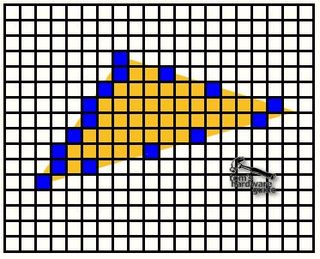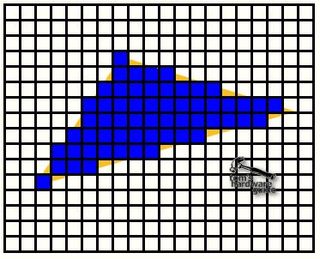High-Tech And Vertex Juggling - NVIDIA's New GeForce3 GPU
What Happens In The 3D-Pipeline Before The Pixel Shader? Continued
The triangle setup computes triangle for triangle the parameters required for the rasterization of the triangles, amongst other things it defines the pixel coordinates of the triangle outline. This means that it defines the first and the last pixel of the triangle scanline by scanline.

The result looks somewhat likes this.
The rasterizer fills in the pixels for each line.

At this stage the triangle exists only in 2D anymore, but each pixel of it has of course a z-value, which was interpolated for each pixel by the rasterizer as well. Color values (depending on the shading mechanism) and texture coordinates need to be interpolated for each pixel too, all according to the values of the three vertices that define the triangle. You can see that the triangle setup/rasterizer has quite a lot to do. For each pixel it has to send a huge amount of data to the rendering pipeline. In Geforce3 the triangle setup/rasterizer has to be able to deliver at least 4 pixels/clock to feed the four rendering pipelines.
The lines of pixels representing the triangle are sent to the pixel-rendering engine, in GeForce3's case to the Pixel Shader. Along with it goes z, color and texture information for each pixel.
GeForce3 has another stage in between the triangle setup and the Pixel Shader, which is part of the Lightspeed Memory Architecure. I will get to this feature later and discuss this stage there.
Stay on the Cutting Edge
Join the experts who read Tom's Hardware for the inside track on enthusiast PC tech news — and have for over 25 years. We'll send breaking news and in-depth reviews of CPUs, GPUs, AI, maker hardware and more straight to your inbox.
Current page: What Happens In The 3D-Pipeline Before The Pixel Shader? Continued
Prev Page The Programmable Pixel Shader Of GeForce3 Next Page The Basics Of GeForce3's Pixel ShaderMost Popular

